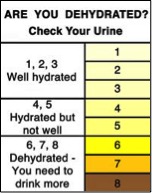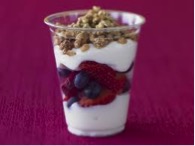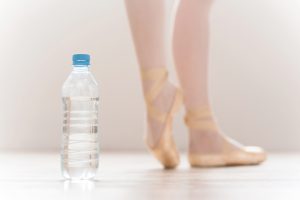 The Importance of Hydration
The Importance of Hydration
How to manage your water intake
by Sally Harrison, Perfect Form Physiotherapy
Water: It is one of the basic components of the body, and crucial to sustaining life. Therefore, I will address the important topic of hydration for the dancer and elite performer – as well as for people in general!
Up to 80% of the body is made from water, it is vital for the function of the cells, heat regulation, muscle contraction, healthy digestion and elimination of waste. We can die without water in as little as 3 days especially if we are sick or the environment is not favourable.
 It has been shown that a loss of as little as 2% of body mass in water is enough to reduce performance. Losses of greater than this will lead to worse symptoms of dizziness, vomiting, disorientation and ultimate organ failure.
It has been shown that a loss of as little as 2% of body mass in water is enough to reduce performance. Losses of greater than this will lead to worse symptoms of dizziness, vomiting, disorientation and ultimate organ failure.
A lot of us spend life in a mild state of dehydration and don’t drink enough under normal circumstances let alone when exercising. Remember, if you are thirsty you are already dehydrated!! Another easy indicator is that our urine should be clear/pale yellow throughout the day and we should be going to the toilet at least 5-6 times in the day.
Don’t forget our fascia (bands of tissue) relies upon good hydration and water content to move, glide and remain ‘unstuck’.
Dehydration = sticky tissue = loss flexibility
So how do we manage our hydration?
The first step is to work out how much water we should be drinking under normal circumstances. We can follow this calculation >> body weight kg x .033 = amount in litres
This amount can be obtained with water, fresh juices, tea, milk throughout the day. Although some research suggests that the effect is negligible, coffee is considered to be a diuretic and actually assists in the loss of water.
To help us with hydration we need to carry water with us so we can sip it regularly throughout the day. There are a great variety of metal water bottles about now in the shops. This is preferable to plastic as they reduce the chance of bacteria growth in the bottle or chemicals leaching into the water especially if the plastic bottle is left out in the hot sun, not to mention the environmental benefits of using a reusable metal bottle.
It is easy to make water more interesting by adding in a slice of fresh lemon/lime /cucumber/mint leaves/boiled ginger root/fresh coconut milk. We can also add a small pinch of Himalayan rock salt or Celtic sea salt to our water to help increase mineral content of the water and aid absorption into the system. It should be minimal however so that we can’t taste the salt in the water.
It is better to drink filtered water over tap water so as to reduce the degree of leached pesticides and other chemicals that can be present in tap water.
There are a great range of filters available now also and even some ‘pump’ style drinking bottles with a built in filter.
Sports drinks
So what is the sports drink? A sports drink is designed to combine the right balance of fluid and carbohydrates to ensure that they are rapidly absorbed into the intestines and blood stream, and available for use. Carbohydrate content should not exceed 8% however. Electrolytes are also often included also (mainly potassium and sodium) to aid fluid absorption and retention. Some others may even boast the addition of vitamins and herbs to aid recovery.
Sports drinks are very commonly seen now and are even drunk regularly throughout the day even when not exercising. This kind of drink however is only really required if exercise is very intense and is lasting over 90 minutes continuously. This is not normally how we train with dancing.
A sports water has less carbohydrate and electrolyte content however and may be suitable for exercise under 60 min. Plain water will be just as effective here however, or maybe add some fresh juice to add some sugar for energy.
In general, energy drinks are not required as a choice… at all!
Exercise
We lose water when we exercise due to sweating/temperature regulation and the increase in demand of an exercising metabolism. It is therefore very important to remain hydrated when exercising and replenish well afterwards.
Below are some tips:
- Start exercise well hydrated (water should suffice) maybe 5ooml before starting class.
- Develop a plan for during exercise based on your sweat rates. Take a water bottle in the class with you.
- Continue to drink after exercise, at least a further 500ml in the following hour. If class was particularly demanding, maybe a small snack with carbohydrate and protein to help recovery (eg. yoghurt, nuts).
- Normal amount of water required is: weight kg x.033 (when not exercising)
- Drink plenty before you dance
- Drink regularly during class
- Rehydrate after class
- Urine should be clear/pale yellow
- Water is normally adequate for the dancer, maybe some fresh diluted fruit or vegetable juice will help with a longer day of training.
- Add something real into your water for flavour such as lemon, mint leaves, cucumber, etc.
- If you’re thirsty, you are already dehydrated.
- Thirst can present as hunger, so drink first before reaching for a snack.

Sally Harrison
Enjoy xx
Sally
www.perfectformphysio.com.au









